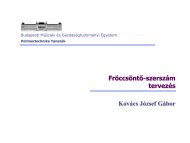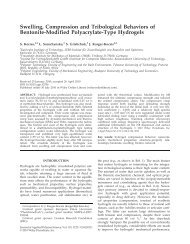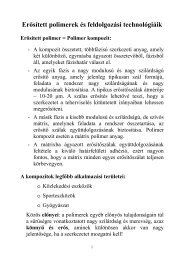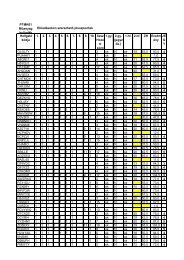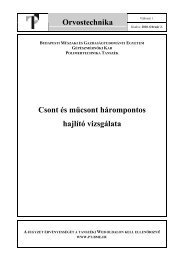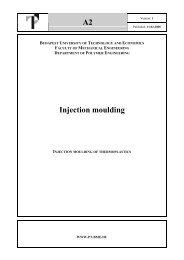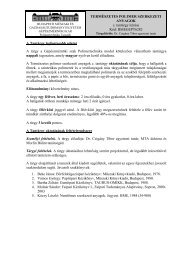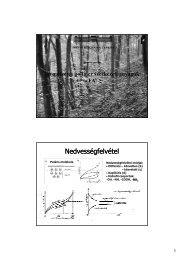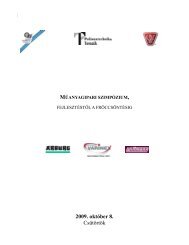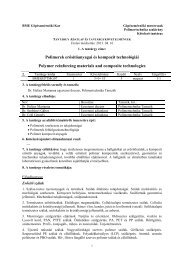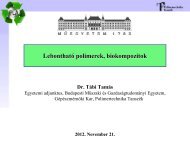Flexural creep of all-polypropylene composites: Model analysis
Flexural creep of all-polypropylene composites: Model analysis
Flexural creep of all-polypropylene composites: Model analysis
You also want an ePaper? Increase the reach of your titles
YUMPU automatically turns print PDFs into web optimized ePapers that Google loves.
effect and increased the total cryst<strong>all</strong>inity <strong>of</strong> the testspecimens by secondary cryst<strong>all</strong>ization. The <strong>creep</strong> resistance<strong>of</strong> the <strong>all</strong>-PP <strong>composites</strong> at higher temperature wastherefore supposed to be higher than would have beenexpected without a change in material property. Hencethe master curves, generated by superimposing the <strong>creep</strong>data obtained at different temperatures to the reference,predicted lower <strong>creep</strong> strains or higher <strong>creep</strong> resistancefor the <strong>all</strong>-PP <strong>composites</strong> compared with the Findleypower law prediction. Note that Fig. 7 also shows that themelting temperature increased from 1658C to 1678C forUD <strong>all</strong>-PP <strong>composites</strong> as a result <strong>of</strong> secondary cryst<strong>all</strong>ization.This also supports our explanation that additionalcryst<strong>all</strong>ization occurred while conducting short-term <strong>creep</strong>tests at different temperatures. However it raises a questionwhether the TTS principle or the Findley equationcan be used univers<strong>all</strong>y to successfully predict the longterm<strong>creep</strong> performance <strong>of</strong> semicryst<strong>all</strong>ine thermoplastics,like the <strong>all</strong>-PP <strong>composites</strong>, whose T g (about 08C) issignificantly lower than the test temperatures. It can beargued here that the Findley power law is an oversimplified<strong>creep</strong> model that does not take into account <strong>of</strong> thechange in material property during the test. On the otherhand TTS can be considered as more precise since it is asuperposition <strong>of</strong> the <strong>creep</strong> data obtained at different temperatures.The debate will, however, continue as towhether Findley or TTS can be considered reliable insuch cases. Nevertheless the predicted <strong>creep</strong> strain wasfound to be obviously lower for the UD <strong>composites</strong>,which once more showed the effectiveness <strong>of</strong> the reinforcingarchitecture on the <strong>creep</strong> behavior. Thus from themodel <strong>analysis</strong> <strong>of</strong> the <strong>creep</strong> curves it appears that the basicproperty that changes due to the change in the reinforcementarchitecture is the viscoelasticity. When the <strong>all</strong>-PP tapes were consolidated unidirection<strong>all</strong>y, the elastic aswell as the retardant modulus <strong>of</strong> the <strong>composites</strong> increased;correspondingly their viscosity also became higher whichlead to a lower instantaneous <strong>creep</strong> strain followed bydecreasing coefficient <strong>of</strong> the time-dependent term, e F .SpecimenTABLE 4.Summary <strong>of</strong> the results <strong>of</strong> DSC <strong>analysis</strong>.Cryst<strong>all</strong>inity (%)T m (8C)Before After Before AfterUD 51 56.5 165 167CP 49.5 54.5 161 162CONCLUSIONThe experimental results showed a dependency <strong>of</strong> the<strong>creep</strong> behavior on the reinforcement architecture <strong>of</strong> <strong>all</strong>-PP<strong>composites</strong> with higher <strong>creep</strong> resistance achievable whenthe <strong>all</strong>-PP tapes are reinforced unidirection<strong>all</strong>y. Both theBurger and Findley power law model could be satisfactorilyapplied to simulate the short-term <strong>creep</strong> behavior andthe modeling results provided a comprehensive understanding<strong>of</strong> the deformation mechanism for these <strong>composites</strong>ystems. The parameter <strong>analysis</strong> based on the Burgermodel showed higher elastic and viscous componentsassociated with the <strong>all</strong>-PP <strong>composites</strong> when the PP tapeswere consolidated unidirection<strong>all</strong>y. Analysis <strong>of</strong> the Findleymodel showed lower instantaneous <strong>creep</strong> strain and adecreasing coefficient <strong>of</strong> the time-dependent <strong>creep</strong> termfor unidirection<strong>all</strong>y laid up <strong>all</strong>-PP tapes. The viscoelasticmodels thus indicated that viscoelastic property changedconsiderably by changing the reinforcement architecture.It could also be concluded from the above results that the<strong>creep</strong> mechanism <strong>of</strong> the <strong>all</strong>-PP <strong>composites</strong> is not alteredby the reinforcement architecture but their <strong>creep</strong> behavioris affected significantly. A comparison between the Findleyprediction based on the model parameters at 308C andthe TTS principle (obtained at T ref ¼ 308C) showed thatthe later predicted a lower <strong>creep</strong> strain at larger timescales. This unexpected behavior could be explained bythe change in cryst<strong>all</strong>inity <strong>of</strong> the material while performingthe short-term <strong>creep</strong> at higher temperatures. Howevera question still remains whether the TTS principle or theFindley equation can be successfully applied to predictthe long-term <strong>creep</strong> for material systems like <strong>all</strong>-PP <strong>composites</strong>whose glass transition temperature is well belowthe test temperature and the microstructural change canoccur during the test. Nevertheless it has been suggestedhere that TTS can provide a more precise prediction insuch cases since it involves a superposition <strong>of</strong> the <strong>creep</strong>data at different temperatures.REFERENCESFIG. 7. DSC thermograms <strong>of</strong> the UD <strong>all</strong>-PP <strong>composites</strong> before andafter performing the <strong>creep</strong> test.1. T. Peijs, Mater. Today, 6, 30 (2003).2. N. Cabrera, B. Alcock, J. Loos, and T. Peijs, Proc. Inst.Mechanical Eng. J. Mater.: Design Appl., 218, 145 (2004).3. B. Alcock, N.O. Cabrera, N.-M. Barkoula, J. Loos, and T.Peijs, Compos. A, 37, 716 (2006).4. B. Alcock, N.O. Cabrera, N.-M. Barkoula, J. Loos, and T.Peijs, Compos. A, 38, 147 (2007).DOI 10.1002/pen POLYMER ENGINEERING AND SCIENCE—-2008 947




